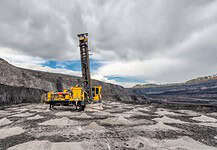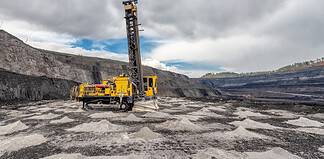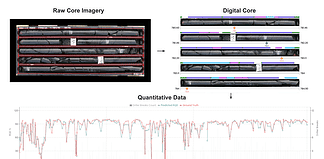A diamond rig at Doolgunna.
All images: Sandfire Resources
BY: JESSICA CUMMINS
A cashed up Sandfire Resources is pursuing a multi-pronged strategy to replace production from its depleting flagship DeGrussa operation, which is expected to reach the end of its life in 2022 on current reserves.
SANDFIRE’s replacement and growth strategy includes taking advantage of M&A opportunities in Australia and overseas, an aggressive $30 million regional exploration campaign around DeGrussa, and the rapid development of its $US250m Black Butte project in Montana.
The recent $72.3m purchase of Talismans’ 30 per cent interest in the Springfield Exploration and Mining Joint Venture gives Sandfire full ownership of the Monty copper-gold development, Springfield and Halloween West.
Neighbouring Sandfire’s Doolgunna project, Monty is being developed as a new satellite underground mine to feed the DeGrussa processing plant, 10 km away. Development continues to move ahead of schedule, with the production expected in the first quarter of 2019.
The acquisition also strengthens the company’s exploration and development pipeline in the Bryah Basin and surrounds. Sandfire Resources chief executive officer Karl Simich said it was a win-win for both Talisman and Sandfire.
“What it does is simplify the ownership structure. It removes a number of levels of complexity between us owning 70 per cent, Talisman owning 30 per cent, and Sandfire buying some of the 30 per cent of the ore that we technically don’t own and trucking it to DeGrussa,” Mr Simich said.
“If anything new was to [be discovered] we will pay a royalty of 1 per cent over any new deposits discovered.”
A March farm in agreement with Auris Minerals’ over its prospective Morck’s Well project, about 22km south of DeGrussa, is also paying dividends.
In June, Sandfire received assay results for a recent aircore drilling campaign, which intersected narrow zones of sulphide and supegene copper mineralisation. Significant results included 11m grading 3.5 per cent copper from 73m, containing 3m grading 9.5 per cent copper from 81m.
The company said while the high grade intersections were narrow, the overall tenor and grade was encouraging and supported continued exploration along this corridor.
Mr Simich said he remains confident of another company-making discovery around DeGrussa.
“Even though we’ve been in the field for a little while, in exploration terms we’ve barely started,” he said.
“That region has significant potential for further similar deposits, high grade volcanogenic hosted sulphide ore bodies of copper, gold, silver, and potentially lead. Exploration endeavours will continue to be extensive.”
“There will be more discoveries of VMS ore bodies in the DeGrussa region – I can’t tell you the size or the timing, but it will happen.”
Black Butte Copper Project
Through its North American affiliate Sandfire Resources America, Sandfire has a 78 per cent stake in Montana’s Black Butte project—one of the world’s top 10 undeveloped copper projects by grade, and a key plank in the company’s long term growth plans.
Black Butte’s Johnny Lee deposit boasts a measured and indicated resource of 11.57 million tonnes with an average grade of 3.57 per cent. The company is currently moving through the approvals process, with a final Environmental Impact Statement expected by the end of 2018 and a Record of Decision anticipated in early 2019.
“You talk to anyone in the US and they will say they can’t believe how quickly our permitting process is going,” Mr Simich said.
“It’s an ore body that has some 600,000 plus tonnes of contained copper with a three and a half per cent copper grade.
“It has zero impediment to take it to production from a technical perspective, and we are going through the final stages of permitting as provided for in the legislation there.”
Mr Simich said the company expected the mining license to be issued by the second quarter of next year, and for Black Butte to be in production by first quarter of 2021.
In June, respected Sandfire Resources America chief John Shanahan suddenly passed away. Rob Scargill, who recently joined Sandfire America as Project Development vice president and as a Sandfire America director, was appointed interim chief executive officer.
Mr Simich said Mr Shanahan had left an indelible imprint on Sandfire America and on the communities of White Sulphur Springs, Helena, and beyond.
“His warm and open leadership style allowed him to engage widely with stakeholders, communities, governments and regulatory authorities, and lead a growing team which is focused on developing a world-class project that will bring many benefits to the State of Montana,” he said in a statement.
“His loss will be keenly felt, not just by those of us within the Sandfire family in Australia and North America, but also by the many friends and former colleagues who knew him or worked alongside him during a distinguished career spanning many decades in mining, mine finance and commodity trading globally.”
The Balkans and Beyond
Sandfire is also looking to the Balkans for further greenfields opportunities. In May, the company announced a $2m cornerstone investment in ASX-listed, Bosnia & Herzegovina –focused explorer Adriatic Metals.
The companies also entered into a strategic partnership agreement, which includes the formation of a technical collaboration committee aimed at developing the polymetallic Veovaca and Rupice projects.
Drilling results released in June confirmed Rupice’s exciting prospects. The very first hole of a 15,000m drilling program produced 64m grading 4.6 g/t gold, 537 g/t silver, 7.7 per cent lead, 10.8 per cent zinc, and 46 per cent barite.
“It’s the most extraordinary drill hole – the results were off the Richter scale,” Mr Simich said.
Mr Simich said it was part of the company’s strategy to dip its toes into the pool of smaller prospects that may not fit into its larger global plan.
“Sandfire has a business strategy, and that strategy is looking for tier 1 and tier 2 assets that have the ability to produce 30,000 tonnes of copper or copper equivalent, and that have at least a 5 year mine life with significant prospectivity,” he said.
“However, in addition to this we would allocate a quantum of money to smaller [prospects] that don’t fit into our big strategic plan but provide exposure to people and opportunities.”










































